Ice Sheet Model Intercomparison Project (ISMIP) Tests
Goals
- Test the ISSM skills that you have gained so far
- Create ISSM models by Following the given keyword instructions
- Run tests from the Ice Sheet Model Intercomparison Project (ISMIP - Tests A and F) (see publication for more information about these tests)
Go to <ISSM_DIR>/examples/ISMIP/ to do this tutorial.
Introduction/How To
The runme.m file and *par files give a layout of the simulation that has to be modified.
- Each code line that has to be typed in is preceded by
\%->. Type the appropriate code below this symbol. - Keywords introduced by
#should be typed in MATLAB to get more information, if necessary - See the solutions below if you get stuck.
Test A
In Test A, we will generate a Square ice sheet flowing over a bumpy bed:
- Sinusoidal bedrock
- Ice frozen on the bed
- Periodic boundary conditions

Simulation File Layout and Organization
The simulation file runme.m is organized into different steps, each with the same structure:
- Model loading
- Performing an action
- Model saving The step specifier
stepsis defined at the top of therunme.mfile.
Mesh
In place of loading a preceding model we initialize one. The action here is the generation of a mesh. To do this initialize md as a new model (#help model) and generate a squaremesh (#help squaremesh) with the following parameters. Afterward, plot the mesh and save the model.
- Mesh size: 80,000 meters
- Nodes in each direction: 20

Load the preceding step (#help loadmodel). Path is given by the organizer with the name of the given step. Set the mask (#help setmask). Note that all MISMIP nodes are grounded. Plot the given mask (md.mask) to locate the field. Save the model.
- Mesh size: 80,000 meters
- Nodes in each direction: 20
- All grounded: default
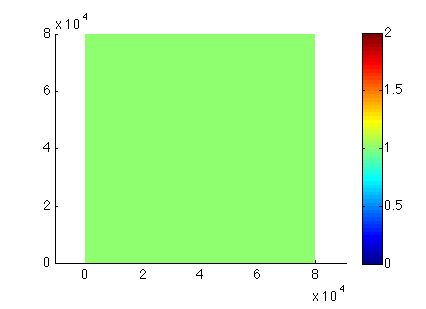
Parameterization
Load the preceding step. Next, parameterize the model (#help parameterize). You will need to fill up the parameter file (given by the name ParamFile variable). Save the given model. It is important to note that the values are not important as we are dealing with a no-sliding flux. The values will be overridden by the basal boundary conditions. Take care of the size of the parameters.
- Mesh size: 80,000 meters
- Nodes in each direction: 20
- All grounded: default
- Ice-flow parameter:
B = 6.8067 x 10^7 Pa s^1/n - Glen’s exponent: n = 3
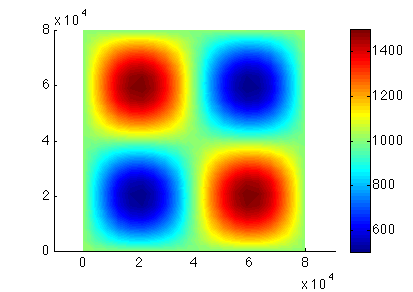
Extrusion
Load Parameterization model. The action here is to extrude the preceding mesh. Next, vertically extrude the preceding mesh (#help extrude) with only 5 layers exponent 1. Plot the 3D geometry and save the model.
- Mesh size: 80,000 meters
- Nodes in each direction: 20
- All grounded: default
- Ice-flow parameter:
B = 6.8067 x 10^7 Pa s^1/n - Glen’s exponent: n = 3
- 5 layer extrusion
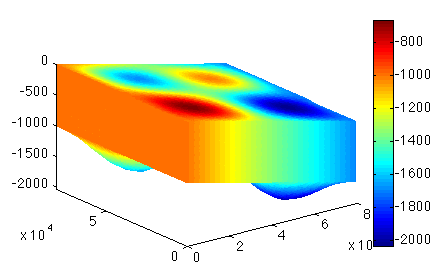
Flow Equation
Load the Extrusion model and set the approximation for the flow computation (#help setflowequation). We will be using the Higher Order Model (HO). Save the model.
- Mesh size: 80,000 meters
- Nodes in each direction: 20
- All grounded: default
- Ice-flow parameter:
B = 6.8067 x 10^7 Pa s^1/n - Glen’s exponent: n = 3
- 5 layers extrusion
- Flow model: HO
Boundary Conditions
Load the SetFlow model. Dirichlet boundary condition are known as SPC’s, where ice is frozen to the base with no velocity. SPC’s are initialized at NaN one value per vertex. Extract the nodenumbers at the base (#md.mesh.vertexonbase) and set the sliding to zero on the bed (Vx and Vy). Periodic boundaries have to be fixed on the sides. Create tabs with the side of the domain for x, and create maxX (#help find). This command give subsets of matrices based on boolean operations. Now create minX. For y, max X and min X should be excluded. Now create min Y. Set the node that should be paired together (#md.stressbalance.vertex_pairing). If we are dealing with IsmipF the solution is in masstransport. Save the given model. (#md.masstransport.vertex_pairing = md.stressbalance.vertex_pairing).
- Mesh size: 80,000 meters
- Nodes in each direction: 20
- All grounded: default
- Ice-flow parameter:
B = 6.8067 x 10^6 Pa s^1/n - Glen’s exponent: n = 3
- 5 layer extrusion
- Flow model: HO
Solve Model
Load the BoundaryConditions model. Set the cluster (#md.cluster) with generic parameters (#help generic). Set only the name and number of processes. Set which control message you want to see (#help verbose.) Solve (#help solve). We are solving a StressBalance. Save the model, and plot the surface velocities.
- Mesh size: 80,000 meters
- Nodes in each direction: 20
- All grounded: default
- Ice-flow parameter:
B = 6.8067 x 10^7 Pa s^1/n - Glen’s exponent: n = 3
- 5 layers extrusion
- Flow model: HO

Test F
Square ice sheet flowing over a bump.
- Gaussian bumped bedrock
- Ice frozen or sliding on the bed
- Periodic boundary conditions
- Transient model until steady-state
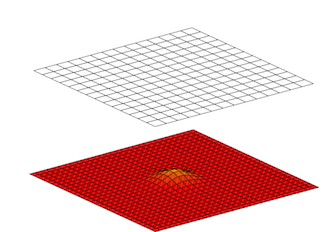
Model Setup
- Mesh size: 100,000 meters
- Nodes in each direction: 30
- All grounded: default
- Ice-flow parameter:
B = 1.4734 x 10^14 Pa s^1/n(or,B = A^(-1/n)wheren = 1andA = 2.140373 x 10^-7 Pa^-1 yr^-1) - Glen’s exponent: n = 1
- 5 layers extrusion
- Flow model: HO
Actual Work and Results
Load the preceding model under the path given by the organizer with the name of the given step. Set the cluster with generic parameters. Set only the name and number of the process. Set which control message you want to see. Set the transient model to ignore the thermal model (#md.transient). Define the timestepping scheme. Everything here should be provided in years (#md.timestepping). Give the length of the time step (4 years). Give the final_time (20 * 4 years time_steps). Now solve, we are solving for TransientSolution. Lastly plot the surface velocities. Here is the upper surface velocity:
Side view:
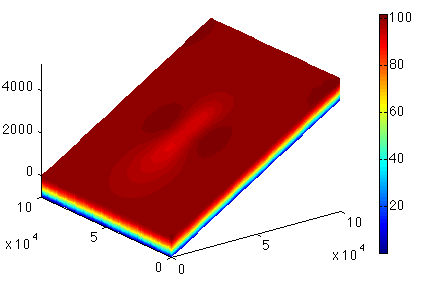
Top view:
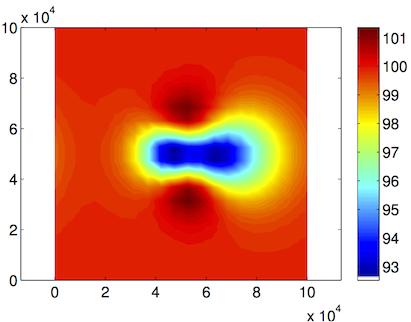
Solution for runme.m (MATLAB)
%which steps to perform; steps are from 1 to 8
%step 7 is specific to ISMIPA
%step 8 is specific to ISMIPF
steps = [1:7]; %ISMIPA
%steps = [1:6, 8]; %ISMIPB
% parameter file to be used, choose between IsmipA.par or IsmipF.par
ParamFile = 'IsmipA.par'
%ParamFile = 'IsmipF.par'
%Run Steps
%Mesh Generation #1
if any(steps == 1)
%initialize md as a new model #help model
%->
md = model();
% generate a squaremesh #help squaremesh
% Side is 80 km long with 20 points
%->
if(ParamFile == 'IsmipA.par'),
md = squaremesh(md, 80000, 80000, 20, 20);
elseif(ParamFile == 'IsmipF.par'),
md = squaremesh(md, 100000, 100000, 30, 30);
end
% plot the given mesh #plotdoc
%->
plotmodel(md, 'data', 'mesh')
% save the given model
%->
save ./Models/ISMIP.Mesh_generation md;
end
%Masks #2
if any(steps == 2)
% load the preceding step #help loadmodel
% path is given by the organizer with the name of the given step
%->
md = loadmodel('./Models/ISMIP.Mesh_generation');
% set the mask #help setmask
% all MISMIP nodes are grounded
%->
md = setmask(md, '', '');
% plot the given mask #md.mask to locate the field
%->
plotmodel(md, 'data', md.mask.ocean_levelset);
% save the given model
%->
save ./Models/ISMIP.SetMask md;
end
%Parameterization #3
if any(steps == 3)
% load the preceding step #help loadmodel
% path is given by the organizer with the name of the given step
%->
md = loadmodel('./Models/ISMIP.SetMask');
% parametrize the model # help parameterize
% you will need to fill up the parameter file defined by the
% ParamFile variable
%->
md = parameterize(md, ParamFile);
% save the given model
%->
save ./Models/ISMIP.Parameterization md;
end
%Extrusion #4
if any(steps == 4)
% load the preceding step #help loadmodel
% path is given by the organizer with the name of the given step
%->
md = loadmodel('./Models/ISMIP.Parameterization');
% vertically extrude the preceding mesh #help extrude
% only 5 layers exponent 1
%->
md = extrude(md, 5, 1);
% plot the 3D geometry #plotdoc
%->
plotmodel(md, 'data', md.geometry.base)
% save the given model
%->
save ./Models/ISMIP.Extrusion md;
end
%Set the flow computing method #5
if any(steps == 5)
% load the preceding step #help loadmodel
% path is given by the organizer with the name of the given step
%->
md = loadmodel('./Models/ISMIP.Extrusion');
% set the approximation for the flow computation #help setflowequation
% We will be using the Higher Order Model (HO)
%->
md = setflowequation(md, 'HO', 'all');
% save the given model
%->
save ./Models/ISMIP.SetFlow md;
end
%Set Boundary Conditions #6
if any(steps == 6)
% load the preceding step #help loadmodel
% path is given by the organizer with the name of the given step
%->
md = loadmodel('./Models/ISMIP.SetFlow');
% dirichlet boundary condition are known as SPCs
% ice frozen to the base, no velocity #md.stressbalance
% SPCs are initialized at NaN one value per vertex
%->
md.stressbalance.spcvx = NaN * ones(md.mesh.numberofvertices, 1);
%->
md.stressbalance.spcvy = NaN * ones(md.mesh.numberofvertices, 1);
%->
md.stressbalance.spcvz = NaN * ones(md.mesh.numberofvertices, 1);
% extract the nodenumbers at the base #md.mesh.vertexonbase
%->
basalnodes = find(md.mesh.vertexonbase);
% set the sliding to zero on the bed
%->
md.stressbalance.spcvx(basalnodes) = 0.0;
%->
md.stressbalance.spcvy(basalnodes) = 0.0;
% periodic boundaries have to be fixed on the sides
% Find the indices of the sides of the domain, for x and then for y
% for x
% create maxX, list of indices where x is equal to max of x (use >> help find)
%->
maxX = find(md.mesh.x == max(md.mesh.x));
% create minX, list of indices where x is equal to min of x
%->
minX = find(md.mesh.x == min(md.mesh.x));
% for y
% create maxY, list of indices where y is equal to max of y
% but not where x is equal to max or min of x
% (i.e, indices in maxX and minX should be excluded from maxY and minY)
%->
maxY = find(md.mesh.y == max(md.mesh.y) & md.mesh.x ~= max(md.mesh.x) & md.mesh.x ~= min(md.mesh.x));
% create minY, list of indices where y is equal to max of y
% but not where x is equal to max or min of x
%->
minY = find(md.mesh.y == min(md.mesh.y) & md.mesh.x ~= max(md.mesh.x) & md.mesh.x ~= min(md.mesh.x));
% set the node that should be paired together, minX with maxX and minY with maxY
% #md.stressbalance.vertex_pairing
%->
md.stressbalance.vertex_pairing = [minX, maxX; minY, maxY];
if (ParamFile == 'IsmipF.par')
% if we are dealing with IsmipF the solution is in
% masstransport
md.masstransport.vertex_pairing = md.stressbalance.vertex_pairing;
end
% save the given model
%->
save ./Models/ISMIP.BoundaryCondition md;
end
%Solving #7
if any(steps == 7)
% load the preceding step #help loadmodel
% path is given by the organizer with the name of the given step
%->
md = loadmodel('./Models/ISMIP.BoundaryCondition');
% Set cluster #md.cluster
% generic parameters #help generic
% set only the name and number of process
%->
md.cluster = generic('name', oshostname(), 'np', 2);
% Set which control message you want to see #help verbose
%->
md.verbose = verbose('convergence', true);
% Solve #help solve
% we are solving a StressBalanc
%->
md = solve(md, 'Stressbalance');
% save the given model
%->
save ./Models/ISMIP.StressBalance md;
% plot the surface velocities #plotdoc
%->
plotmodel(md, 'data', md.results.StressbalanceSolution.Vel)
end
%Solving #8
if any(steps == 8)
% load the preceding step #help loadmodel
% path is given by the organizer with the name of the given step
%->
md = loadmodel('./Models/ISMIP.BoundaryCondition');
% Set cluster #md.cluster
% generic parameters #help generic
% set only the name and number of process
%->
md.cluster = generic('name', oshostname(), 'np', 2);
% Set which control message you want to see #help verbose
%->
md.verbose = verbose('convergence', true);
% set the transient model to ignore the thermal model
% #md.transient
%->
md.transient.isthermal = 0;
% define the timestepping scheme
% everything here should be provided in years #md.timestepping
% give the length of the time_step (4 years)
%->
md.timestepping.time_step = 4;
% give final_time (20 * 4 years time_steps)
%->
md.timestepping.final_time = 4 * 20;
% Solve #help solve
% we are solving a TransientSolution
%->
md = solve(md, 'Transient');
% save the given model
%->
save ./Models/ISMIP.Transient md;
% plot the surface velocities #plotdoc
%->
plotmodel(md, 'data', md.results.TransientSolution(20).Vel)
end
Solution for runme.m (Python)
import numpy as np
from model import *
from squaremesh import squaremesh
from plotmodel import plotmodel
from export_netCDF import export_netCDF
from loadmodel import loadmodel
from setmask import setmask
from parameterize import parameterize
from setflowequation import setflowequation
from socket import gethostname
from solve import solve
#which steps to perform; steps are from 1 to 8
#step 7 is specific to ISMIPA
#step 8 is specific to ISMIPF
steps = [1, 2, 3, 4, 5, 6, 8]
# parameter file to be used, choose between IsmipA_cor.py or IsmipF_cor.py
ParamFile = 'IsmipF_cor.py'
#Run Steps
#Mesh Generation #1
if 1 in steps:
print("Now generating the mesh")
#initialize md as a new model help(model)
#->
md = model()
# generate a squaremesh help(squaremesh)
# Side is 80 km long with 20 points
#->
if ParamFile == 'IsmipA_cor.py':
md = squaremesh(md, 80000, 80000, 20, 20)
elif ParamFile == 'IsmipF_cor.py':
md = squaremesh(md, 100000, 100000, 30, 30)
# plot the given mesh plotdoc()
#->
plotmodel(md, 'data', 'mesh', 'figure', 1)
# save the given model
#->
export_netCDF(md, "./Models/ISMIP-Mesh_generation.nc")
#Masks #2
if 2 in steps:
print("Setting the masks")
# load the preceding step help(loadmodel)
# path is given by the organizer with the name of the given step
#->
md = loadmodel("./Models/ISMIP-Mesh_generation.nc")
# set the mask help(setmask)
# all MISMIP nodes are grounded
#->
md = setmask(md, '', '')
# plot the given mask #md.mask to locate the field
#->
plotmodel(md, 'data', md.mask.ocean_levelset, 'figure', 2)
# save the given model
#->
export_netCDF(md, "./Models/ISMIP-SetMask.nc")
#Parameterization #3
if 3 in steps:
print("Parameterizing")
# load the preceding step #help loadmodel
# path is given by the organizer with the name of the given step
#->
md = loadmodel("./Models/ISMIP-SetMask.nc")
# parametrize the model # help parameterize
# you will need to fill up the parameter file (given by the
# ParamFile variable)
#->
md = parameterize(md, ParamFile)
# save the given model
#->
export_netCDF(md, "./Models/ISMIP-Parameterization.nc")
#Extrusion #4
if 4 in steps:
print("Extruding")
# load the preceding step #help loadmodel
# path is given by the organizer with the name of the given step
#->
md = loadmodel("./Models/ISMIP-Parameterization.nc")
# vertically extrude the preceding mesh #help extrude
# only 5 layers exponent 1
#->
md = md.extrude(5, 1)
# plot the 3D geometry #plotdoc
#->
plotmodel(md, 'data', md.geometry.base, 'figure', 3)
# save the given model
#->
export_netCDF(md, "./Models/ISMIP-Extrusion.nc")
#Set the flow computing method #5
if 5 in steps:
print("setting flow approximation")
# load the preceding step #help loadmodel
# path is given by the organizer with the name of the given step
#->
md = loadmodel("./Models/ISMIP-Extrusion.nc")
# set the approximation for the flow computation #help setflowequation
# We will be using the Higher Order Model (HO)
#->
md = setflowequation(md, 'HO', 'all')
# save the given model
#->
export_netCDF(md, "./Models/ISMIP-SetFlow.nc")
#Set Boundary Conditions #6
if 6 in steps:
print("setting boundary conditions")
# load the preceding step #help loadmodel
# path is given by the organizer with the name of the given step
#->
md = loadmodel("./Models/ISMIP-SetFlow.nc")
# dirichlet boundary condition are known as SPCs
# ice frozen to the base, no velocity #md.stressbalance
# SPCs are initialized at NaN one value per vertex
#->
md.stressbalance.spcvx = np.nan * np.ones((md.mesh.numberofvertices))
#->
md.stressbalance.spcvy = np.nan * np.ones((md.mesh.numberofvertices))
#->
md.stressbalance.spcvz = np.nan * np.ones((md.mesh.numberofvertices))
# extract the nodenumbers at the base #md.mesh.vertexonbase
#->
basalnodes = np.nonzero(md.mesh.vertexonbase)
# set the sliding to zero on the bed (Vx and Vy)
#->
md.stressbalance.spcvx[basalnodes] = 0.0
#->
md.stressbalance.spcvy[basalnodes] = 0.0
# periodic boundaries have to be fixed on the sides
# Find the indices of the sides of the domain, for x and then for y
# for x
# create maxX, list of indices where x is equal to max of x (use >> help find)
#->
maxX = np.squeeze(np.nonzero(md.mesh.x == np.nanmax(md.mesh.x)))
# create minX, list of indices where x is equal to min of x
#->
minX = np.squeeze(np.nonzero(md.mesh.x == np.nanmin(md.mesh.x)))
# for y
# create maxY, list of indices where y is equal to max of y
# but not where x is equal to max or min of x
# (i.e, indices in maxX and minX should be excluded from maxY and minY)
#->
maxY = np.squeeze(np.nonzero(np.logical_and.reduce((md.mesh.y == np.nanmax(md.mesh.y), md.mesh.x != np.nanmin(md.mesh.x), md.mesh.x != np.nanmax(md.mesh.x)))))
# create minY, list of indices where y is equal to max of y
# but not where x is equal to max or min of x
#->
minY = np.squeeze(np.nonzero(np.logical_and.reduce((md.mesh.y == np.nanmin(md.mesh.y), md.mesh.x != np.nanmin(md.mesh.x), md.mesh.x != np.nanmax(md.mesh.x)))))
# set the node that should be paired together, minX with maxX and minY with maxY
# #md.stressbalance.vertex_pairing
#->
md.stressbalance.vertex_pairing = np.hstack((np.vstack((minX + 1, maxX + 1)), np.vstack((minY + 1, maxY + 1)))).T
if ParamFile == 'IsmipF_cor.py':
# if we are dealing with IsmipF the solution is in masstransport
md.masstransport.vertex_pairing = md.stressbalance.vertex_pairing
# save the given model
#->
export_netCDF(md, "./Models/ISMIP-BoundaryCondition.nc")
#Solving #7
if 7 in steps:
print("running the solver for the A case")
# load the preceding step #help loadmodel
# path is given by the organizer with the name of the given step
#->
md = loadmodel("./Models/ISMIP-BoundaryCondition.nc")
# Set cluster #md.cluster
# generic parameters #help generic
# set only the name and number of process
#->
md.cluster = generic('name', gethostname(), 'np', 2)
# Set which control message you want to see #help verbose
#->
md.verbose = verbose('convergence', True)
# Solve #help solve
# we are solving a StressBalance
#->
md = solve(md, 'Stressbalance')
# save the given model
#->
export_netCDF(md, "./Models/ISMIP-StressBalance.nc")
# plot the surface velocities #plotdoc
#->
plotmodel(md, 'data', md.results.StressbalanceSolution.Vel, 'figure', 4)
#Solving #8
if 8 in steps:
print("running the solver for the F case")
# load the preceding step #help loadmodel
# path is given by the organizer with the name of the given step
#->
md = loadmodel("./Models/ISMIP-BoundaryCondition.nc")
# Set cluster #md.cluster
# generic parameters #help generic
# set only the name and number of process
#->
md.cluster = generic('name', gethostname(), 'np', 2)
# Set which control message you want to see #help verbose
#->
md.verbose = verbose('convergence', True)
# set the transient model to ignore the thermal model
# #md.transient
#->
md.transient.isthermal = 0
# define the timestepping scheme
# everything here should be provided in years #md.timestepping
# give the length of the time_step (4 years)
#->
md.timestepping.time_step = 1
# give final_time (20 * 4 years time_steps)
#->
md.timestepping.final_time = 1 * 20
# Solve #help solve
# we are solving a TransientSolution
#->
md = solve(md, 'Transient')
# save the given model
#->
export_netCDF(md, "./Models/ISMIP-Transient.nc")
# plot the surface velocities #plotdoc
#->
plotmodel(md, 'data', md.results.TransientSolution[19].Vel, 'layer', 5, 'figure', 5)
Solution for IsmipA.par (MATLAB)
%Parameterization for ISMIP A experiment
%Set the Simulation generic name #md.miscellaneous
%->
%Geometry
disp(' Constructing Geometry');
%Define the geometry of the simulation #md.geometry
%surface is [-x * tan(0.5 * pi / 180)] #md.mesh
%->
md.geometry.surface = -md.mesh.x * tan(0.5 * pi / 180.);
%base is [surface - 1000 + 500 * sin(x * 2 * pi / L) .* sin(y * 2 * pi / L)]
%L is the size of the side of the square #max(md.mesh.x) - min(md.mesh.x)
%->
L = max(md.mesh.x) - min(md.mesh.x);
md.geometry.base = md.geometry.surface - 1000.0 + 500.0 * sin(md.mesh.x * 2.0 * pi / L) .* sin(md.mesh.y * 2.0 * pi / L);
%thickness is the difference between surface and base #md.geometry
%->
md.geometry.thickness = md.geometry.surface - md.geometry.base;
%plot the geometry to check it out
%->
plotmodel(md, 'data', md.geometry.thickness);
disp(' Defining friction parameters');
%These parameters will not be used but need to be fixed #md.friction
%one friction coefficient per node (md.mesh.numberofvertices, 1)
%->
md.friction.coefficient = 200.0 * ones(md.mesh.numberofvertices, 1);
%one friction exponent (p, q) per element
%->
md.friction.p = ones(md.mesh.numberofelements, 1);
%->
md.friction.q = ones(md.mesh.numberofelements, 1);
disp(' Construct ice rheological properties');
%The rheology parameters sit in the material section #md.materials
%B has one value per vertex
%->
md.materials.rheology_B = 6.8067e7 * ones(md.mesh.numberofvertices, 1);
%n has one value per element
%->
md.materials.rheology_n = 3 * ones(md.mesh.numberofelements, 1);
disp(' Set boundary conditions');
%Set the default boundary conditions for an ice-sheet
% #help SetIceSheetBC
%->
md = SetIceSheetBC(md);
Solution for IsmipA.py (Python)
Solution for IsmipF.par (MATLAB)
%Parameterization for ISMIP F experiment
%Set the Simulation generic name #md.miscellaneous
%->
%Geometry
disp(' Constructing Geometry');
%Define the geometry of the simulation #md.geometry
%surface is [-x * tan(3.0 * pi / 180)] #md.mesh
%->
md.geometry.surface = -md.mesh.x * tan(3.0 * pi / 180.0);
%base is [surface - 1000 + 100 * exp(-((x - L / 2) .^ 2 + (y - L / 2) .^ 2) / (10000.^2))]
%L is the size of the side of the square #max(md.mesh.x) - min(md.mesh.x)
%->
L = max(md.mesh.x) - min(md.mesh.x);
%->
md.geometry.base = md.geometry.surface - 1000.0 + 100.0 * exp(-((md.mesh.x - L / 2.0) .^ 2.0 + (md.mesh.y - L / 2.0) .^ 2.0) / (10000.^2.0));
%thickness is the difference between surface and base #md.geometry
%->
md.geometry.thickness = md.geometry.surface - md.geometry.base;
%plot the geometry to check it out
%->
plotmodel(md, 'data', md.geometry.thickness);
disp(' Defining friction parameters');
%These parameters will not be used but need to be fixed #md.friction
%one friction coefficient per node (md.mesh.numberofvertices, 1)
%conversion form year to seconds with #md.constants.yts
%->
md.friction.coefficient = sqrt(md.constants.yts / (1000 * 2.140373 * 10^-7)) * ones(md.mesh.numberofvertices, 1);
%one friction exponent (p, q) per element
%->
md.friction.p = ones(md.mesh.numberofelements, 1);
%->
md.friction.q = zeros(md.mesh.numberofelements, 1);
disp(' Construct ice rheological properties');
%The rheology parameters sit in the material section #md.materials
%B has one value per vertex
%->
md.materials.rheology_B = (1 / (2.140373 * 10^-7 / md.constants.yts)) * ones(md.mesh.numberofvertices, 1);
%n has one value per element
%->
md.materials.rheology_n = 1 * ones(md.mesh.numberofelements, 1);
disp(' Set boundary conditions');
%Set the default boundary conditions for an ice-sheet
% #help SetIceSheetBC
%->
md = SetIceSheetBC(md);
disp(' Initializing velocity and pressure');
%initialize the velocity and pressurefields of #md.initialization
%->
md.initialization.vx = zeros(md.mesh.numberofvertices, 1);
%->
md.initialization.vy = zeros(md.mesh.numberofvertices, 1);
%->
md.initialization.vz = zeros(md.mesh.numberofvertices, 1);
%->
md.initialization.pressure = zeros(md.mesh.numberofvertices, 1);
Solution for IsmipF.py (Python)
import numpy as np
from plotmodel import plotmodel
from SetIceSheetBC import SetIceSheetBC
#Parameterization for ISMIP F experiment
#Set the Simulation generic name #md.miscellaneous
#->
md.miscellaneous.name = 'IsmipF_cor'
#Geometry
print(' Constructing Geometry')
#Define the geometry of the simulation #md.geometry
#surface is [-x * tan(3.0 * pi / 180)] #md.mesh
#->
md.geometry.surface = md.mesh.x * np.tan(3.0 * np.pi / 180.0)
#base is [surface - 1000 + 100 * exp(-((x - L / 2) .^ 2 + (y - L / 2) .^ 2) / (10000.^2))]
#L is the size of the side of the square #max(md.mesh.x) - min(md.mesh.x)
#->
L = np.nanmax(md.mesh.x) - np.nanmin(md.mesh.x)
#->
md.geometry.base = md.geometry.surface - 1000.0 + 100.0 * np.exp(-((md.mesh.x - L / 2.0) ** 2.0 + (md.mesh.y - L / 2.0) ** 2.0) / (10000.**2.0))
#thickness is the difference between surface and base #md.geometry
#->
md.geometry.thickness = md.geometry.surface - md.geometry.base
#plot the geometry to check it out
#->
plotmodel(md, 'data', md.geometry.thickness)
print(' Defining friction parameters')
#These parameters will not be used but need to be fixed #md.friction
#one friction coefficient per node (md.mesh.numberofvertices,1)
#conversion form year to seconds with #md.constants.yts
#->
md.friction.coefficient = np.sqrt(md.constants.yts / (1000 * 2.140373 * 1e-7)) * np.ones((md.mesh.numberofvertices))
#one friction exponent (p, q) per element
#->
md.friction.p = np.ones((md.mesh.numberofelements))
#->
md.friction.q = np.zeros((md.mesh.numberofelements))
print(' Construct ice rheological properties')
#The rheology parameters sit in the material section #md.materials
#B has one value per vertex
#->
md.materials.rheology_B = (1 / (2.140373 * 1e-7 / md.constants.yts)) * np.ones((md.mesh.numberofvertices))
#n has one value per element
#->
md.materials.rheology_n = np.ones((md.mesh.numberofelements))
print(' Set boundary conditions')
#Set the default boundary conditions for an ice-sheet
# #help SetIceSheetBC
#->
md = SetIceSheetBC(md)
print(' Initializing velocity and pressure')
#initialize the velocity and pressurefields of #md.initialization
#->
md.initialization.vx = np.zeros((md.mesh.numberofvertices))
#->
md.initialization.vy = np.zeros((md.mesh.numberofvertices))
#->
md.initialization.vz = np.zeros((md.mesh.numberofvertices))
#->
md.initialization.pressure = np.zeros((md.mesh.numberofvertices))